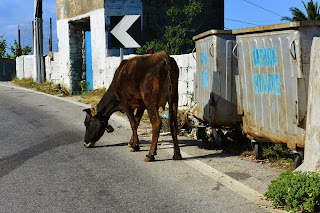Sailing in the Ionian
One of the best things about our gypsy life is that we no
longer live by the clock. We do not have
to get up at a certain time each day, we eat our meals when we are hungry and
we set sail for a new destination when we feel like finding a new taverna or
want a change of scenery.
So far, in all our travels, we have found the Ionian Sea to be the best place to sail. Each morning we
wake to water as flat as glass, gradually the wind builds up through the day
until, by mid afternoon, we have a 15-20kn. sea breeze, ideal for sailing from
one island to the next. By 9 p.m. the
wind and sea swell have totally died, the water becomes like glass once again,
and it is so still that one could play billiards in the boat throughout the
night! That suits me just fine as, with
no movement, the boat is QUIET, with no squeaks and creaks and no water
slapping at the stern. It means that I can sleep undisturbed.
 |
| Morning mist in Amvrakikos Gulf |
The Ionian islands are very beautiful. They seem to have a higher rainfall than the rest of Greece , as they are very green. Many have fairly high, cloud-capped mountains and the lower slopes are treed with Pine and Cypress .
 |
| Kefallonia Island-cave with emerald water |
 |
| Bronze age village from the time of Homer's Illiad - these people may have fought in Troy! |
There is a lot of history here, these islands having been taken
at some stage or another by the Minoans, Romans, Venetians, Turks, French and English.
We are now on Kefallonia, the little island of “Captain Corelli’s Mandolin”
fame.
Since we left Corfu , we
have met few land-based tourists. People
who are sailing their own yachts here are mostly British. Many have had their
boats here for 8 – 10 years and they spend one or two holidays a year in this
area. Some people live aboard
permanently and we saw four French boats in a little bay, tied securely to
trees ashore, where they live permanently (free of charge), home schooling
their children and going into the nearby village for supplies. Charter boats
are also prominent, but the further south we move from Corfu ,
the fewer we see.
We are not yet in full summer season so there is always
plenty of space on the quay to tie up.
Having said that, we have not tied up once this summer, except while we
were in Albania ,
preferring to anchor. It is better for
the boat, quieter away from other boats, roads and restaurants and we are away
from mosquitoes, and most importantly – rats!
Rats are a very big problem for boats.
They are prevalent in all waterside situations and in ports and they
find no problem running along mooring
lines to get onto a boat. Once onboard,
it is the devil’s job to catch them, and meanwhile, they merrily chew the
boat’s electrical wires etc.
The water is crystal clear and one can watch the anchor drop and see exactly where it lands.
The weather is now warmer and we are beginning to swim. We see little fish which school around the
hull. In the large Amvrakikos Gulf
 |
| Dolphin escorting us into the Amvrakikos Gulf |
The Amvrakikos Gulf Greece . It is connected to the Ionian
Sea by a very narrow entrance, so sailing within it is more like
sailing on a lake than on the sea. It is
a very quiet place, with several small, quaint
villages and many quiet, deserted bays to anchor in. Few yachts go into the gulf, preferring to
stay on the nearby islands so mostly, one has the place to oneself.
 |
| On our own, outside the little village of Vonitsa |
After leaving the Amvrakikos Gulf, Levkada
Canal
 |
| Opening bridge in the Levkada Canal |
The Ionian islands have
many little bays so it is easy to find an anchorage. Usually one finds a waterside taverna there
as well, even though it may be quite some distance from the nearest village.
 |
| Waterside taverna, Vathy, on Meganisi island |
We
have found that there are no strong winds, like the Boras of Croatia, it’s much
cheaper and the beaurocracy
is much more obliging, too.
On our way to the island
of Meganisi , we passed the island of Skorpios
That’s all for now folks.
Fair winds
Artemis and Dimitri.






















